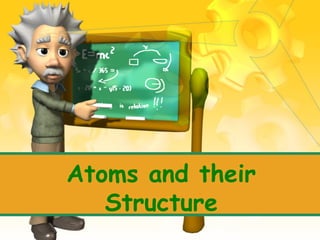
Ps ch 3_presentation
- 3. Models of the Atom
- 4. Bohr modelcompared electrons to planets • Because science is always changing, we realized that Bohr’s model could not explain all of our observations!!
- 5. Electrons are found in orbitals-behave like wavesquantum theory! There are four kinds of orbitals: s orbitals p orbitals d orbitals f orbitals
- 6. Each orbital has a different amount of energy Orbitals closer to the nucleus have less energy than orbitals further from the nucleus
- 10. Valence Electrons Electrons that are found in the outermost energy level of an atom How do we know how many valence electrons a particular atom has???
- 11. The first orbital can hold electrons 2 The second and third orbitals can each hold 8 electrons Higher orbitals are more complicated and will be learned in Chemistry class!
- 12. How many valence electrons would an electrically neutral Carbon atom have??? Carbon has 6 protons, therefore an electrically neutral atom would need 6 electrons to balance the charge
- 13. Carbon’s first orbital can only have 2 electrons 6 total electrons – 2 first shell electrons leaves 4 electrons in the outer shell (valence shell)
- 15. A Tour of the Periodic Table
- 16. Periodic Law says: 1) Properties of elements tend to change according to a regular pattern when those elements are arranged by increasing atomic number!!
- 17. What does this mean??? It means that elements with certain characteristics in common (like # of valence electrons) are more likely to have similar chemical properties (like what kinds of atoms they react with!)
- 18. Periods and Groups Horizontal Rows (leftright) are called PERIODS Handy for determining valence shell electrons!!
- 19. Periods and Groups Vertical columns (up-down) are called GROUPS All elements in a particular group will have the same number of valence electrons, which gives them all similar chemical properties
- 20. Atoms that have lost or gained electrons are called…IONS Atoms that have lost or gained neutrons are called…ISOTOPES
- 21. Cation=atom that has lost electrons, giving it a positive charge i.e. Li + Anion=atom that has gained electrons, giving it a negative charge i.e. Cl -
- 22. Metals -most elements are metals -good conductors of heat and electricity -most are fairly reactive
- 23. Metals continued Alkali Metals-found in Group 1 -Highly reactive -one valence electron -readily form cations (+) -not found naturally in nature-why?
- 24. Alkaline Earth Metals -Found in Group 2 -Very reactive, but not as reactive as Alkali Metals -2 valence electrons -readily form cations (+2) -too reactive to be found alone in nature
- 25. TRANSITION METALS Groups 3-12 Can form more than one cation, depending on what they are bonding with Very useful in technology and economy
- 26. Nonmetals Found on the right side of the periodic table Very plentiful on earth-especially carbon, silicon, oxygen, nitrogen, and sulfur Readily form anions by gaining electrons to form full outer shells
- 27. Halogens -elements in Group 17 -very reactive, especially with alkali metals! -7 valence electrons-only need ?? To have a full shell… -form anions (-1) by GAINING that one missing electron
- 28. Noble Gases-Group 18 -Found in Group 18 -all inert gases -full valence shells-do not need to get any more electrons, therefore they do not react with other atoms or elements -will not form ions
- 29. Semiconductors Found on the “stairsteps” Intermediate conductors of heat and electricity-not as good as metals, but better than nonmetals Classified as nonmetals, but have some properties of metalssometimes called “metalloids”
- 30. Using Moles to Count Atoms The mole is a counting unit, much like “dozen” or “pair” A dozen = 12 objects A pair = 2 objects A mole = 6.022 x 10 23 objects 6.022 x 10 23 is known as Avogadro's constant
- 31. Molar Mass Average atomic mass is the mass of 1 atom Molar mass is the mass of 1 mole of atoms The number is the same for both of these and can be found on the periodic table, usually under the Chemical symbol for that particular element The only difference for these two values is the unit you use -Atomic Mass Unit vs grams/mole
- 32. Conversion Factors Just as we used a conversion factor to do our metric conversions, we will use a conversion factor to go from moles → mass and mass → moles
- 33. More Conversion Factors For our purposes, the conversion factor is the molar mass of an element-found on the periodic table So... 1 mole Carbon = 12.011 grams 12.011 grams Carbon = 1 mole
Notas do Editor
- {}